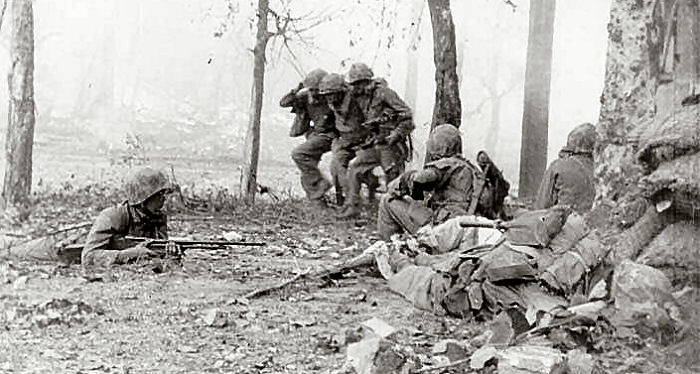The initial M1918A1 version of the Browning Automatic Rifle (BAR) was first used in combat by American soldiers during World War I, and many saw service in World War II. The BAR received high praise for its reliability under adverse conditions.
In 1940, the model M1918A2 was adopted. Unlike earlier models, it could only be fired in two automatic modes--slow (300 to 450 rpm) or fast (500 to 650 rpm)--but not in semiautomatic mode. Both versions were widely used in the second world war. The USMC preferred the semiautomatic mode in some tactical situations, and modified most of the M1918A2 guns to include that capability. A buffer spring in the butt greatly reduced recoil, to the advantage both of firing accuracy and shooter endurance
The M1918A2 also mounted its folding bipod (2.38 pounds!) on a special flash hider near the end of the barrel. Since the bipod could easily be detached in this model, it very frequently was! but not often in defensive positions, where it was very effective. The flash hider, which was the point of attachment for the bipod, was not usually removed. Hiding the flash from enemy troops when firing on them isn't the purpose of the hider, all automatic weapons are easily visible when fired at night. It blocks the muzzle flash from the vision of the shooter, maintaining his night vision. That's important!
The Army infantry squad of nine men was tactically organized around a single BAR. The Marine squad of thirteen men was organized around three fire-teams, each organized around a BAR. The much greater fire power of a Marine platoon with its nine BARs over the Army platoon with its four BARs was a great combat advantage.
The BAR was a popular weapon in WWII and Korea, because it was very reliable and offered an excellent combination of rapid fire and penetrating power. The BAR's only serious drawbacks were its lack of a quick-change barrel (to reduce the chance of overheating), and its weight (BAR, with bipod and a loaded bandoleer, came to about 25 pounds).
In Korea, the much greater range and penetrating power of the BAR and the .30 caliber air cooled machine gun, firing rifle ammunition, usually more than offset the light weight and rapid fire capability of the variety of submachine guns the North Koreans and Chinese used, including their burp guns modeled on Soviet weapons such as the Shpagin PPSh41 , which fired pistol ammunition.



